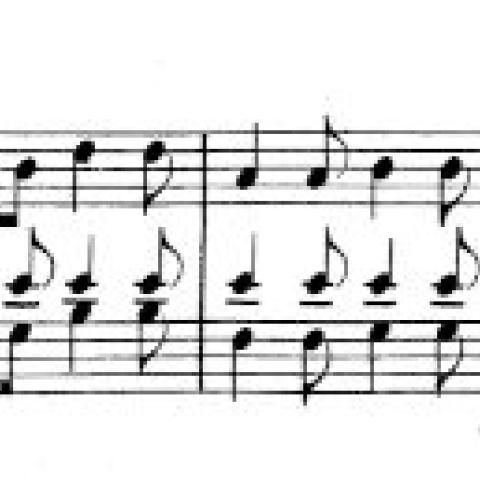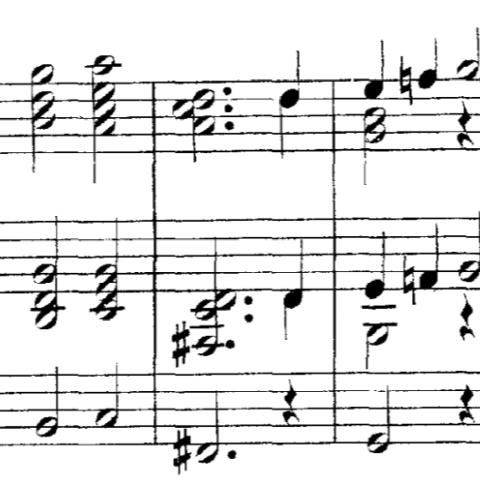Gavin Black is director of the Princeton Early Keyboard Center in Princeton, New Jersey.

Further thoughts about rhythm, part 2
Continuing from my September column, I offer here a few additional anecdotes and ideas relevant to rhythm and the teaching of rhythm. In my next column I will explore the question of how to teach rhythm or “counting” in a way that enables a student to connect those concepts as directly as possible with rhetoric and the student’s interpretive stance.
I begin by revisiting the anecdote from the last column about my colleague who, in the eyes of a particular third party, “couldn’t count.” Since I wrote that, I have had further relevant thoughts. I remember that as I walked into the rehearsal studio after that exchange, I was very sorry to have been told my colleague’s opinion. I did not want to approach my work with this fellow musician with any preconceptions. And while I certainly did not assume that the older colleague was right, I found it hard not to have a question layered on top of my focus during rehearsal. “Was that rhythm correct? Is this where I learn that she indeed cannot count?” That was distracting.
I wondered why he wanted me to focus my attention on her rhythmic deficiencies. Why did it matter in the overall picture? Why tell me as I headed into the rehearsal that “she can’t count” rather than that “she is an amazingly compelling performer?” This seems like a manifestation of bias in favor of that which can be quantified—that which seems more objective or safer to describe.
Since that day decades ago, I have become very aware that there is a strong pull in all sorts of areas of life to focus on things that can be measured and described in a way that is objective to some extent. It is a truism that in evaluating a competition, for example, or even just in reviewing a concert or a recording, it is relatively easier to note that a performance either does or does not get all the right notes, or that the rhythms are or are not all in strict accordance with the notation, or that the tempo is or is not the same as what the composer requested.
It is much more difficult to describe how expressive or moving a performance is. This is not a bad thing, and competition judges and reviewers certainly do not fail to grapple with the elusive side of things. But this has some bearing on teaching rhythm and counting. On paper, rhythm is one of the most objective matters about music—at least with our familiar rhythmic notation. Quarter notes are twice as long as eighth notes, etc. In a way, some of what is non-objective can even be described objectively. Certain dotted-note patterns, for example, are not meant to be what they apparently look like on the page, and we can often describe the ways that they differ from that presentation.
But how do we teach subtle variations in rhythms that look the same on paper? Is it an acceptable part of our understanding of rhythm for there to be such variations? If we think not, is that for musical reasons, or is it because of this pull toward the objective? If a quarter note is really always exactly twice as long as an eighth note, if all the eighth notes are really exactly the same as one another, what does that mean for a student or for how we teach? And if they are not, what does that mean? Is it possible that rhythmic notation means “these notes should be in any rhythmic relationship that would be expressed more closely this way than any other way?”
Another story from many years ago: I was coaching an amateur chamber music group—a violinist, a flautist, and a pianist who was exploring the harpsichord as part of this project. At that time, in my own work as a player I was exploring Sweelinck and beginning to discover some ideas about freedom of rhythm. At one point I played a segment of a Sweelinck toccata for the members of the group and drew their attention to a particular passage. This was one where I felt that the rhetorical force and expressiveness of the music could be enhanced by playing very freely. I had an approach to that passage that involved drawing out the development of harmonic tension and, when it was resolved, using timing to make it seem difficult to go on. That is a trite and inadequate description, but the point is that it called for freedom, and the musicians in the room found it very effective. I also played through the passage as written, and they found that almost embarrassingly boring and pointless, which was exactly what I intended to convey. So far, so good. But when we had finished this and were ready to get back to rehearsal, one of the musicians said, “Of course, you couldn’t do that with Bach.”
So, the question I had, and still have, is, “Why not?” Anyone may or may not appreciate the rhythmic choices performers exercise. In theory, there could be a plausible analysis of a Bach piece that concludes that free rhythm, or any particular approach to rhythm, might not be effective. And the question of what the composer himself would have thought always looms over our thinking about an issue like this. But none of that is what was meant by that remark that day. We discussed it, and the ensemble member specifically meant that since listeners’ expectations about Bach were pretty well formed already, unlike their expectations of Sweelinck, it would be imprudent to go too far in violating those expectations. To some extent, the way that music had been played and heard in then-recent decades had become part of the actual identity of that music. This seems to be another way in which something objective can gain a kind of privilege or priority that it might not have earned in any substantive way.
Another question that I will delve into more next month is, why rhythm? That is, what is the goal of having music organized into regular or somewhat regular micro units of time? Is it to create a sense of pulse or momentum? Is it something about comparability of experience throughout the duration of a piece or a movement? Is it very specifically about creating the palpable sense of a regular beat in the listener’s ear?
I mention it here to introduce an experiment I once conducted that was predicated on the observation that many people are of the opinion that Helmut Walcha’s recordings are rhythmically conservative. I obtained an interesting result.
I had always reacted to Walcha’s recording of Sweelinck’s Fantasia Chromatica as having both extreme steadiness and inexorable forward momentum. At the time that I did the experiment, I took it for granted that the way to achieve those qualities was to keep the beat very steady. But I must have suspected something that led me to investigate. I put on the LP and measured the beat at the opening. I then picked the needle up and dropped it a bit farther in. I measured again. I did it a third time, maybe a fourth. They were all quite different. This led to the intriguing notion that maybe inexorable forward momentum, and even the very sense of steadiness itself, might sometimes come from something other than regimented sameness of beat.
I have now repeated this exercise using more modern methods: the piece playing on my computer and an online tempo tool. The beat at the beginning hovered around 118, and later on it was over sustained passages as high as about 126 and as low as the mid 90s. That is very much like what I measured thirty years ago. I am intensely interested in the relationship between literal sameness of beat—or departures from that—and a subjective sense of steadiness, momentum, and pulse. Is it possible that sometimes a performance that features a doggedly steady beat comes across as uneven to listeners? If so, how can this be?
There are two games that I have played while riding in a car that both have to do with the use of time in music. First, if you are riding along a fairly busy two-way street or highway, pay attention to the sound of the cars passing on the opposite side. On a busy road cars will space themselves out almost regularly, since all else being equal, people pay at least a little bit of attention to following distance in front and behind. But there’s an emphasis on “almost.” The line of cars is never spaced out exactly evenly. So as the “whoosh” of each successive car goes by, see how far from even those sounds can be and if you can still accept them as conceptually even. How far apart can sounds 2 and 3 be—compared to the time between sounds 1 and 2—and can you still hear that timing as rubato or agogic accent rather than just discontinuity? For me there is a wider range of timings that I can assimilate to evenness than I would have expected.
If you can accept a stream of not quite even cars as conceptually even, is there anything interesting about the shape of the unevenness? Does it have any rhetoric to it, groupings or patterns of weak and strong beats, or impulses? One fascinating feature of this exercise is that each instance of it is ephemeral: you can hear it only once, never again the same way.
Another exercise I enjoy while driving is this: when going under an overpass, I try to experience the time in the shadow of that overpass as lasting forever. Since it will come to an end, usually in seconds or less than a second, I attempt to experience it as simultaneously brief and infinite. This feels even more intense if it is raining. It seems to me this has implications for rhythm in music. The ostensible rhythm, flow, motion of any increment of music is always about the next thing: when will the next beat come? But the state of being of each note, harmony, sonority, or beat, is also a thing that exists for as long as it exists, and that has identity and importance.
(It is probably best to do the above exercises as a passenger rather than as the driver, unless you are very sure that none of it will distract you from driving. I wonder how different any of this will seem if we have nothing but self-driving cars on the road!)
Are there other little slices of everyday life that might illuminate aspects of rhythm and the role of time in music? Rain is an interesting one. There are pieces of music that are inspired by or attempt to depict rain. What is the rhythm of rain like? It is more regular when it is fairly light. What about walking? How regular is that, and how does walking respond to outside conditions? Can one walk while hearing in one’s head a passage of music that moves at a pace different from the footsteps?
It occurred to me a few years ago that I often experience trills as containing some of that simultaneously brief and infinite quality that I get out of my second driving exercise. I sometimes suspect that that is what trills are essentially about, though that is speculative and unknowable. The fast and unmeasured quality of (usually) the middle portion of a trill seems to take it out of time, while, like all music, it is in the end bounded and defined by time.
I will pick this up again next month.




